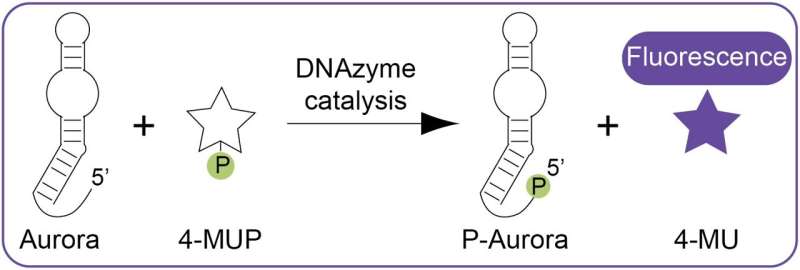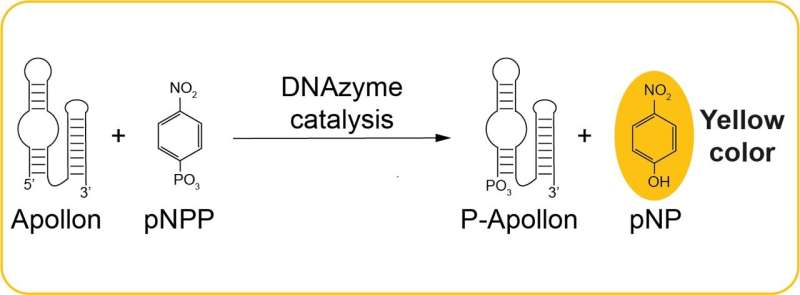This article has been reviewed according to Science X's editorial process and policies. Editors have highlighted the following attributes while ensuring the content's credibility:
fact-checked
peer-reviewed publication
trusted source
proofread
Scientists develop a new generation of DNA tests for a wide range of applications

A research group led by Dr. Edward Curtis has developed two new types of catalytic DNA molecules (deoxyribozymes) that can reveal the presence of target molecules through fluorescence or color. Several types of sensors were also developed, one was used to identify small molecule inhibitors of a ribonuclease from SARS-CoV-2 in a high-throughput screen.
The results of their research were published as two papers in the leading scientific journal Nucleic Acids Research.
Edward Curtis's team has long recognized the significant functional potential of nucleic acids. At one point, it was believed that the main functions of DNA and RNA were to store and transfer genetic information. However, it has now become clear that these remarkable polymers can do much more, including binding target molecules with high affinity and specificity and even catalyzing chemical reactions.
The discovery of DNA or RNA molecules with a desired function is facilitated by a powerful technique called directed evolution. The basic idea is to create an enormous library typically containing a quadrillion (1015) or more random DNA or RNA sequences and purify library members with a desired activity by multiple rounds of selection and amplification.
In their latest work, scientists in the Curtis group used directed evolution to discover novel fluorescent and colorimetric deoxyribozymes. They also developed several different ways to convert these deoxyribozymes into sensors that are only active in the presence of a target molecule.
One sensor was successfully used to detect enzyme inhibitors in a high-throughput screen, and others are being developed to identify molecules that are indicative of specific diseases.

Ph.D. student Martin Volek, the first author of the paper, explains: "Our new DNA enzymes are called Aurora and Apollon. Aurora generates purple fluorescence, while Apollon produces a yellow color.
"Aurora is more sensitive, but the yellow signal from Apollon can be detected by the eye without specialized equipment. This could be particularly useful for diagnostic tests in cases where resources or trained personnel are limited, providing a cheaper, simpler option."
Edward Curtis, who leads the Functional Potential of Nucleic Acids research group at IOCB Prague, refers to the experience gained during the COVID-19 pandemic when PCR and antigen tests were used. Although PCR tests are extremely sensitive, they were used less frequently than antigen tests, which were cheaper and could be used by virtually anyone, anywhere.
Similarly, it is possible that diagnostic kits using the DNA enzyme Apollon, which generates a yellow product that can be detected by the eye, could eventually be used for similar applications.
"If there is another pandemic, we want to be better prepared than we were for the last one," explains Curtis. He adds, "Part of this is the ability to rapidly generate tests for different types of targets."
He and his colleagues are now working on producing a pilot sensor to detect viruses, and using catalytic DNA for this purpose certainly appears to be cost-effective and straightforward.
More information: Martin Volek et al, Apollon: a deoxyribozyme that generates a yellow product, Nucleic Acids Research (2024). DOI: 10.1093/nar/gkae490
Martin Volek et al, Aurora: a fluorescent deoxyribozyme for high-throughput screening, Nucleic Acids Research (2024). DOI: 10.1093/nar/gkae467
Journal information: Nucleic Acids Research





















